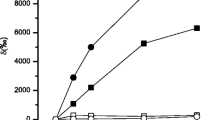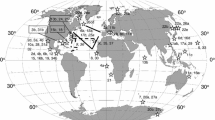Abstract
This paper describes a method which utilizes 14C-labelled glucose for measuring the assimilation and mineralization of dissolved organic compounds in the sea. Incubation is carried out in 500 ml conic flasks, in darkness, at a temperature similar to that of the in-situ sampling levels. Direct trapping of CO2 respired is performed in a scintillation vial, with an efficiency of 92% over a period of 4 h. The hyamin, utilized to trap the CO2, excites the scintillating liquid in the presence of CO2; the respiration data must then be corrected by a factor of 0.62. When HA Millipore filters are used for filtration, they quench assimilation values and the results must be corrected by a factor of 1.06. The reproducibility of the described method is good. Some parameters have been calculated: total heterotrophic activity, assimilation rate, respiration rate, bacterian yield, and the turn-over time of substrate in the water.
Résumé
-
1.
Une méthode de mesure en mer de l'assimilation et de la respiration des composés organiques dissous dans l'eau par les microorganismes hétérotrophes est proposée.
-
2.
Le piègeage du gaz carbonique se fait directement dans une fiole à scintillation liquide, par 1 ml d'hydroxyde de hyamine 10 X imprégné sur un support minéral. 92% de la quantité de CO2 dégagée est récupérée en 4 h d'agitation magnétique.
-
3.
Les comptages de la radioactivité nécessitent des corrections, car la hyamine surestime les quantités de 14CO2 piègées (160% en moyenne) et le filtre Millipore HA, au contraire, abaisse l'efficacité des comptages (94%).
-
4.
La méthode est très sensible: jusqu'à 0,1 ng C/l/h et la reproductibilité des résultats est satisfaisante.
-
5.
La distribution verticale semble cohérente, avec une couche homogène superficielle à activité bactérienne relativement forte et une couche profonde à activité presque nulle.
Similar content being viewed by others
Littérature citée
Allen, H. L.: Chemo-organotrophic utilization of dissolved organic compounds by plankton algae and bacteria in a pond. Int. Revue ges. Hydrobiol. 54, 1–33 (1969).
Barber, R. T.: Dissolved organic carbon resists oxydation. Nature, Lond. 220, 274–275 (1968).
Corner, E. D. S. and A. G. Davies: Plankton as a factor in the nitrogen and phosphorus cycles in the sea. Adv. mar. Biol. 9, 101–204 (1971).
Cuppy, D. and L. Crevasse: An assembly for 14CO2 collection in metabolic studies for liquid scintillation counting. Analyt. Biochem. 5, p. 462 (1963).
Dugdale, R. C. and J. J. Goering: Uptake of new regenerated forms of nitrogen in primary production. Limnol. Oceanogr. 12, 196–206 (1967).
Duncombe, W. G. and T. J. Rising: Scintillation counting of 14CO2 from “in vitro” systems. A comparison of some trapping agents. Analyt. Biochem. 30, 275–278 (1969).
Fallot, P. et M. L. Baszormenyi: Détection par scintillation en milieu liquide et ses applications biologiques. Annls Fac. Sci. Univ. Clermont 15, 27–38 (1963).
Fogg, G. E.: The extracellular products of algae. Oceanogr. mar. Biol. 4, 195–212 (1966).
Hamilton, R. D. and J. E. Preslan: Observations on heterotrophic activity in the eastern tropical Pacific. Limnol. Oceanogr. 15, 395–401 (1970).
Hata, Y., H. Miyoshi and H. Y. Katoda: A new method for estimating the mineralization activity of lake water and sediment. Mem Res. Inst. Food Sci. Kyoto Univ. 27, 28–30 (1966).
Hobbie, J. E. and E. Crawford: Respiration corrections for bacterial uptake of dissolved organic compounds in natural waters. Limnol. Oceanogr. 14, 528–532 (1969).
Johannes, R. E.: Influence of marine protozoa on nutrient regeneration. Limnol. Oceanogr. 10, 434–442 (1965).
— and K. L. Webb: Release of dissolved amino acids by marine zooplankton. Science, N.Y. 150, 76–77 (1965).
Kalbhen, D. A.: Problems of chemoluminescence in liquid sointillation counting, using the hydroxide of hyamine 10 x. Int. J. appl. Radiat. Isotopes 18, 655–656 (1967).
Menzel, D. W. and J. H. Ryther: Distribution and cycling of organic matter in the oceans. In: Symposium on organic matter in naturals waters, pp 31–54. Ed. by D. W. Hood. Alaska: University of Alaska, Institute of Marine Science 1970.
Miras, C. J., G. M. Levis and J. B. Mantzos: A simplified apparatus for collecting 14CO2 for liquid scintillation counting. Radioisotope sample measurement techniques in medicine and biology, pp 471–474. In: Proc. Symp. A.I.E.A., Vienna 1965.
Parsons, T. R. and J. D. H. Strickland: On the production of particulate organic carbon by heterotrophic processes in sea water. Deep Sea Res. 8, 211–222 (1962).
Samuel, S., N. M. Shan and G. E. Fogg: Liberation of extra cellular products of photosynthesis by tropical phytoplankton. J. mar. biol. Ass. U.K. 51, 793–798 (1971).
Stephens, G. C. and B. B. North: Extrusion of carbon accompanying uptake of amino acids by marine phytoplankters. Limnol. Oceanogr. 16, 752–757 (1971).
Vaccaro, R. F. and H. W. Jannasch: Studies on heterotrophic activity in sea water based on glucose assimilation. Limnol. Oceanogr. 11, 596–607 (1966).
Wagner, F. S.: Composition of the dissolved organic compounds in sea water, a review. Contr. mar. Sci. 14, 115–153 (1969).
Williams, P. J. Le B.: Heterotrophic utilization of dissolved organic compounds in the sea. I. Size distribution of population and relationship between respiration and incorporation of growth substrates. J. mar. biol. Ass. U.K. 50, 859–870 (1970).
— and C. Askew: A method of measuring the mineralization by microorganisms of organic compounds in sea water. Deep Sea Res. 15, 365–375 (1968).
Wright, R. T. and J. E. Hobbie: The uptake of organic solutes in lake waters. Limnol. Oceanogr. 10, 22–28 (1965).
——: Use of glucose and acetate by bacteria and algae in aquatic ecosystems. Ecology 47, 447–464 (1966).
Zobell, C. E. and D. Q. Anderson: Observations on the multiplication of bacteria in different volumes of stored sea water, and the influence of oxygen tension and solid surfaces. Biol. Bull. mar. biol. Lab., Woods Hole 71, 324–342 (1936).
Author information
Authors and Affiliations
Additional information
Communicated by J. M. Peres, Marseille
Rights and permissions
About this article
Cite this article
Herbland, A.M., Bois, J.F. Assimilation et minéralisation de la matière organique dissoute dans la mer: méthode par comptage en scintillation liquide. Mar. Biol. 24, 203–212 (1974). https://doi.org/10.1007/BF00391894
Accepted:
Issue Date:
DOI: https://doi.org/10.1007/BF00391894




